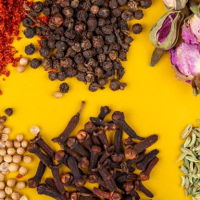Sensory exploration is a type of experiential learning where children discover and examine the world around them through different senses. Engaging multiple senses like sight, touch, smell, taste and hearing helps children better understand and recall the characteristics of a particular thing. For young children in particular, sensory exploration is essential in building neural pathways in the brain, which lays the foundation of cognitive development.
Learning about herbs and spices is a fun and exciting way for kids to experience sensory exploration. With their powerful aromas, unique appearance and distinctive tastes, herbs and spices engage four of the five senses, helping children differentiate between taste, smell, touch and sight.
In this blog, we’ve put together a list of all herbs and spices found commonly in India, as well as some of their characteristics. With this list, you will be able to engage your child in sensory learning right in the comfort of your own home!
Types of Herbs and Spices: An Introduction
Before jumping into learning the characteristics and names of herbs and spices, it is important to understand what they are. Simply put, spices are the dried seeds, roots or barks of plants that are used to season food. Herbs are small plants that enhance the flavor of food and can be used fresh or dried. If you’re interested in growing them at home, learning how to plant seeds properly is essential for healthy growth.
Herbs and spices have been used for cooking for several centuries by different cultures across the world. Our own country of India has always been called the ‘Land of Spices’ because of the numerous variety of spices grown here.
Many herbs and spices have also been used for their medicinal properties throughout the ages. For example, the traditional medicinal practice of Ayurveda relies heavily on the use of herbs and spices.
A List of Common Herbs
- Coriander: More popularly known as dhania, coriander leaves are a staple of Indian cooking. It is vibrant green in color, and has a bright, tangy, and slightly citrusy flavour.
- Mint: With a fresh, invigorating taste that has a bit of a peppery heat, mint is a flavour that is found widely across food items – be it curries, chutneys, sauces, beverages or even chewing gum!
- Curry Leaves: Native to the Indian subcontinent, curry leaves or kadhi patta are an integral part of south Indian cuisine. These dark green leaves have a unique aroma and flavour which is not easy to describe.
- Basil: Today, most recognisable in Italian dishes like pizza and pasta, Basil is a sweet aromatic herb that features in cuisines across the Mediterranean and South East Asia. The variety found in India is called Tulsi, which has been hailed as a sacred herb since ancient times for its health benefits.
- Oregano: Native to the Mediterranean region, Oregano features a robust, earthy flavor with a warm, slightly bitter edge that intensifies with cooking.
- Lemongrass: Indigenous to Southeast Asia, this aromatic herb has a bright, lemony flavour. Although it is called lemongrass, only the bulbs and stalks are actually used in cooking.
- Sage: Throughout Mediterranean history, Sage has been highly regarded for its therapeutic properties. In cooking, it adds a savory, earthy, and slightly peppery flavour.
- Rosemary: Rosemary offers a robust, pine-like flavor accented by hints of lemon and mint, perfect for roasting and grilling.
A list of Common Spices
- Mustard Seeds: A staple ingredient in cuisines across India, mustard seeds are known for their nutty and smoky flavour. There are two main varieties of mustard seeds – the black seeds are called ‘rai’ and are more commonly found in southern and western coastal cuisines, while the yellow seeds – called ‘sarson’ are more common in Bengali and northern cuisines.
- Black Pepper: A spice that is native to southern India, black pepper has a sharp, hot flavour. Although black pepper is most commonly used, there are a number of different kinds of pepper including green, white, pink, and even red!
- Turmeric. Turmeric comes from the root of a plant and has a warm, bitter taste and a deep yellow colour. It also has many medicinal properties, and has been used in traditional Indian and Chinese medicines for many centuries.
- Green Cardamom: Another famous spice that is native to India, cardamom has a strong flavour that can be described as herbal and pungent at the same time. These little seed pods are so powerful, that just one or two of them can flavour an entire dish.
- Black Cardamom: Similar in taste to the Green Cardamom, black cardamom has a smokier flavour, and tends to be larger in size.
- Chillies: Although a staple of Indian food today, chillies are actually native to South America. Today, there are a number of different varieties of chillies in India which range from mild to extremely high levels of spiciness.
- Cumin: Another staple of the Indian kitchen, cumin is a dried seed that is used in many types of cuisines in India and the Mediterranean. It has a sharp earthy flavour characterised by a hint of nuttiness.
- Cloves: Known for its intense flavour that is a mix of sweetness, spiciness and a deep earthy taste, cloves are a staple in cuisines across the world. These flower buds are harvested before they can turn into flowers and dried to give them that distinctive taste.
- Cinnamon: With a flavour profile that is similar to cloves, cinnamon also has an earthy flavour, but it is sweeter and has a gentle warmth. Cinnamon is actually the inner bark of trees from the Cinnamomum species, and has a unique curled appearance.
- Asafoetida. Asafoetida has a unique and distinctive flavour often described as a combination of onion, garlic, and a slightly bitter taste.
At Kangaroo Kids, we believe that everyday life offers invaluable learning opportunities through which children can broaden their perspectives and develop into well-rounded individuals. Our integrated curriculum is designed to curate different kinds of learning experiences along with building a robust academic foundation. To learn more about our curriculum, visit our website or contact our admissions office today!









